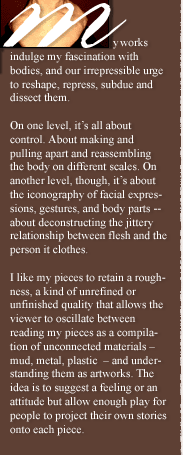PLAYING DRESS-UP FOR GROWNUPS
ANITA EUTENEIER - Ottawa Xpress
Like other girls of her generation, Dorothy Love played with Barbie dolls. And like many other children, she liked to morph them - plugging legs into arm sockets, switching heads, and pulling out hair.
Love parlays her continuing fascination with the iconography of body parts in Private Parts, a series of 12 figural sculptures she calls "dazed and deconstructed beauties."
The female figures ranging from 60 to 182 centimetres. The most animated are the smallest figures mounted on glass bricks. The richly detailed figures appear totemic, with elongated necks and features rendered in terracotta and stoneware. Love adds girlie touches, gold streaks for the hair, and makeup and lipstick sealed with wax.
Bronze legs and arms are rendered in coloured patinas with funky shoes that look like they walked out of a John Fluevog shop. Erect nipples appear on the outside of dresses, something Love said was a play on "the idea of outerwear, inner wear."
In the larger figures that stand on the floor, Love starts with a curvaceous wire form, wrapping it with fiberglass casting tape (the kind used in hospitals for broken bones). The tape has the appearance of gauze, which is then painted to resemble clothing.
"There was something appealing about the whole bandage, bondage idea, and how women repress, reshape and subdue their bodies," said Love in an interview at her studio.
Love, who studied art at St. George's College in Montreal, also cites the influence of the ancient Greek custom of painting statuary.
Private Parts is on at Arts Court (2 Daly Ave.) for one weekend only: Friday, December 6 (opening at 6 p.m.), Saturday, December 7 from 10 a.m. to 8 p.m., Sunday, December 7 from 10 a.m. to 5 p.m.
|




